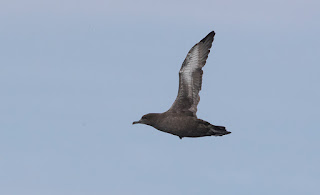Arctic Terns in adult breeding plumage are a beautiful bird. Nature has finely cropped the Arctic Tern providing it maximum lift with minimal effort allowing to spent most of its life on the wing at sea communing between the top and bottom of the earth. We are lucky to have it as fairly common as a nester on the Avalon Peninsula, Newfoundland. It is often with the more numerous Common Tern. While the two species are so similar that they require a good view to identify, the subtle differences between the finely sculpted Arctic Tern and the chunky Common Tern are obvious when experienced closely.
On the weekend I was at Ferryland beach watching a small swarm of kittiwakes, gulls, puffins and terns attracted to the spawning capelin. With the west wind the terns were approaching the beach riding along the edge of a small bluff. A potential set up for photography of one of my favourite photo targets - terns but especially Arctic Terns. It worked out so well on 18th July that I went back for some more on the 20th. I got so many satisfying shots of the Arctics that I couldn't chose a few favourites so I am posting an abundance of favs here. With Arctic Terns you can do that just because of who they are...
Below is a short poem I corrupted from a ZZ Top song.
Sharp Dressed Tern
Long tail, short bill
And I know I am goin' to capelin beach
Silk wings, black cap,
I know the reason why
They come runnin' ‘til their leg’s real burn
'Cause every birder’s crazy 'bout a sharp dressed tern
And I know I am goin' to capelin beach
Silk wings, black cap,
I know the reason why
They come runnin' ‘til their leg’s real burn
'Cause every birder’s crazy 'bout a sharp dressed tern























































